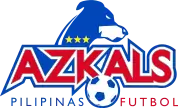Philippines national football team
The Philippines national football team (Filipino/Tagalog: Pambansang koponan ng futbol ng Pilipinas) represents the Philippines in international football, governed by Philippine Football Federation and has been playing at the international level as early as 1913.
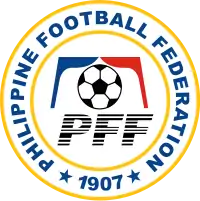 | |||
| Nickname(s) | Azkals[1] (Street Dogs) | ||
|---|---|---|---|
| Association | Philippine Football Federation | ||
| Confederation | AFC (Asia) | ||
| Sub-confederation | AFF (Southeast Asia) | ||
| Head coach | Vacant | ||
| Captain | Stephan Schröck | ||
| Most caps | Phil Younghusband (108) | ||
| Top scorer | Phil Younghusband (52) | ||
| Home stadium | Panaad Stadium | ||
| FIFA code | PHI | ||
| |||
| FIFA ranking | |||
| Current | 124 | ||
| Highest | 111 (May 2018) | ||
| Lowest | 195 (September – October 2006) | ||
| First international | |||
(Manila, Philippines; 1 February 1913) | |||
| Biggest win | |||
(Tokyo, Japan; 10 May 1917)[3] | |||
| Biggest defeat | |||
(Tokyo, Japan; 28 September 1967) | |||
| Asian Cup | |||
| Appearances | 1 (first in 2019) | ||
| Best result | Group stage, (2019) | ||
| AFC Challenge Cup | |||
| Appearances | 3 (first in 2006) | ||
| Best result | Runners-up (2014) | ||
| AFF Championship | |||
| Appearances | 11 (first in 1996) | ||
| Best result | Semi-finals (2010, 2012, 2014, 2018) | ||
Prior to the World War II, the Philippines had regularly competed with Japan and the Republic of China in the Far Eastern Championship Games. So far, the national team has never qualified for the FIFA World Cup[4] and has qualified for the AFC Asian Cup only once, in 2019. They finished second at the 2014 AFC Challenge Cup after losing to Palestine in the final.[5]
Unlike most of Southeast Asia, where football is the most popular, the Philippines' most popular sports are basketball and boxing, the result from the American rule, thus drives away many football talents and contributes to the lack of success of football of the Philippines. Often the Philippines only participated in the AFF Championship and finished bottom. However, starting from 2010 AFF Championship, the country has started to develop football as part of the sport's renaissance, finding more incentives to increase football development and fan support,[6] eventually led to the country's first ever Asian Cup competition, the 2019 edition.[7]
History
1910s–1940s: Early years

The Philippines participated at the Far Eastern Championship Games, which included football. The first edition was in 1913 and the last was in 1934. The games were the first regional football tournament for national teams outside the British Home Championship. The national team routinely faced Japan and China and at one edition the Dutch East Indies at the games. The Philippines won over China at the inaugural tournament with the scoreline of 2–1. During the 1917 edition, the national team achieved its biggest win in international football. Led by Filipino-Spanish icon Paulino Alcantara, the Philippines defeated Japan 15–2.[4][8][9]
After the dissolution of the Far Eastern Championship Games, the national squad participated at the 1940 East Asian Games organized to commemorate the 2600th anniversary of the foundation of the Empire of Japan by Emperor Jimmu. The team finished third behind champions Japan and second placers, Manchukuo and ahead of the Republic of China.[10][11]
1950s–1990s: Decline of football
In the 1950s the Philippines hosted friendlies with international-based sides, However the national team experienced lack of funding and barely received any coverage from the media. During that time talents from the national team were drawn from the Manila Football League which received substantial support from the Chinese-Filipino community. The national team's decent performance at the 1958 Asian Games, hosted in Tokyo, where they defeated Japan, 1–0 in a game which was labeled as an upset by the Japanese press.[12]
After 1958, saw the decline of Philippine football, several key players resigned from the national team due to financial challenges for playing for the national team. National team players Ed Ocampo and Eduardo Pacheco switched to basketball, and went on playing for commercial basketball clubs where players are paid.[12] The Philippine Congress passed Republic Act 3135 that revised the charter of the Philippine Amateur Athletic Federation which had a provision or a 60-40 rule that mandates teams to not have more than 40 percent Chinese and other players with foreign blood.[13] Sponsors withdrew and leagues, which were mostly funded by the Chinese-Filipino community started to decline. The 60–40 rule was lifted much later during the tenure of president Johnny Romualdez of the Philippine Football Federation (PFF), after 1982 when the PFA has reorganized itself as the PFF.[12][14]
The national team suffered defeats with big margins at the 1962 Asian Games in Jakarta.[12] This includes the national team's record 15–1 defeat to Malaysia, which became the worst defeat of the national team at that time. The record was later broken by the 15–0 loss to Japan in 1967 at the qualifiers for the 1968 Summer Olympics. Foreigners were hired to serve as head coaches for the national team in an attempt to reduce big margin loses. Englishman, Allan Rogers was hired following the record defeat to Malaysia and Spaniard Juan Cutillas was likewise tasked to lead the national team following the record defeat to Japan.[15]
In the early sixties, the Philippine Football Association partnered with the San Miguel Corporation to seek foreign assistance to train local football players and coaches and to develop the sport in the country. Coaches from the United Kingdom, Alan Rogers and Brian Birch. After the two were relieved, Danny McClellan and Graham Adams continued their task. In 1961, San Miguel through the national football association bought in four medical students from Spain who were expert in football — Francisco Escarte, Enrique dela Mata, Claudio Sanchez and Juan Cutillas. Escarte and dela Mata left the country after one year.[16]
In 1971, head coach Juan Cutillas recruited five foreign players to play for the national team; four Spaniards and one Chinese. The national team joined several international competitions such as the Merdeka Tournament, Jakarta Anniversary Tournament and the President Park Tournament. The team caused some upset results against the national teams of Thailand, Singapore and South Korea. The national team saw another decline after the four Spanish players left the team due to financial reasons and basketball gains more foothold over football in the country.[16]
The national team under German head coach, Eckhard Krautzun finished fourth overall at the 1991 Southeast Asian Games, its best ever finish at the tournament. The Philippines dealt a 1–0 defeat to defending champions Malaysia at the tournament which knocked out the latter out of the tournament at just the group stage. Norman Fegidero scored the sole goal for the Philippines.[15][17][18]
2000s
In September 2006, the country fell to 195th on the FIFA World Rankings, its lowest ever.[19] By the end of the year, the Philippines moved back up to 171st overall, after a good run in the 2007 ASEAN Football Championship qualification.[20] They were able to win three games in a row which was a first for the Philippines and thus qualifying for the 2007 ASEAN Football Championship.[21] Coach at that time Aris Caslib, aimed to reach the semifinals with two wins at the group stage.[22] The decision came despite Philippine Football Federation president Juan Miguel Romualdez stating that they would still be underdogs in the tournament and that they mustn't raise their expectations too high,[20] as the Philippines have only won their first ever win of the tournament during the 2004 edition.[23]
The Philippines eventually failed to reach their target, only getting a draw in three matches. Their poor performances led to Caslib's resignation,[24] as well as the refusal of the PFF to register and enter the qualification stages for the 2010 FIFA World Cup.[25] They would be one of four nations, all from Southeast Asia not to enter after a record number of entries.[26] However it was revealed that the decision not to enter the 2010 as well as the 2006 World Cup qualification was made during the PFF presidency of Rene Adad, whose term ended in 2003.[25] Instead, the PFF wanted to focus on domestic and regional competitions.[27]
The Philippines failed to qualify for any major competition in 2008. They missed out on the 2008 AFC Challenge Cup only on goal difference,[28] and the 2008 AFF Suzuki Cup with an inferior goals scored record.[29]
Dan Palami, businessman and sports patron, was appointed as team manager of the national team in 2009 by the Philippine Football Federation. The national team still receive minimal support from the government. Palami made financial investments to the team using his own personal money. Since taking responsibility over the national team, he has envisioned a plan named Project 100, which plans to make the team among the top 100 national teams in the world in terms of FIFA rankings. More foreign-born Filipinos were called up to play for the national squad.[30]
2010s: era of renaissance
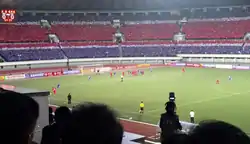
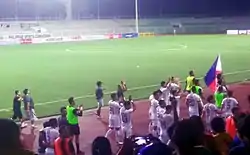
The Philippines's campaign at the 2010 AFF Championship under Simon McMenemy's tenure was a breakthrough. Hold a primal ticket as one of two teams along with Laos that had to qualify for the tournament, the Philippines advanced from the group stage for the first time, did not concede a single defeat and their win against defending champions Vietnam in particular was considered as one of the biggest upsets in the tournament's history.[31] The match, which would later be referred by local Filipino fans as the "Miracle of Hanoi", is also considered as the match that started a football renaissance in the country where basketball is the more popular sport.[32][33] In the knockout stage, they had to play both their designated home and away games against Indonesia in Jakarta due to the unavailability of a stadium that passes AFF standards. The Philippines lost both games to end their campaign.
The following year, Michael Weiß became the head coach. The national team managed to qualify for the 2012 edition of the AFC Challenge Cup, the first time since qualifiers were introduced and also recorded their first ever victory in the FIFA World Cup qualification, beating Sri Lanka 4–0 in the second leg of the first preliminary round.[34] Kuwait finished the Philippines' World Cup qualification campaign after winning over them twice in the second round.
In 2012, the Philippines qualified for the semifinals of the AFC Challenge Cup for the first time winning over defending champions India and Tajikistan though they lost 2–1 against Turkmenistan in the semifinal.[35] In the third place-playoff the Philippines won 4–3 over Palestine.[36] The Philippines won the 2012 Philippine Peace Cup, a friendly tournament hosted at home, which was their first title since the 1913 Far Eastern Games. At the 2012 AFF Championship, the Philippines replicated their performance in 2010 by advancing to the semifinal. They loss to Singapore on aggregate by a single goal in the two-legged semifinal.
The Philippines reached the final of the 2014 AFC Challenge Cup. With a berth to the 2015 AFC Asian Cup on the line, the Philippines lost to Palestine 1–0 on 30 May. The Philippines once again advance from the group stage at the 2014 AFF Championship by winning over Indonesia, the first time since the 1934 Far Eastern Games,[37] and Laos despite their loss to Vietnam.[38] The Philippines faced Thailand in the two-legged semifinal, coming up with a goalless draw against their opponents at home in Manila but losing the away match at Bangkok.[39]
Thomas Dooley became the head coach of the national team. In October 2015 their 2–0 victory Yemen in Doha, Qatar in the 2018 FIFA World Cup and 2019 AFC Asian Cup qualifiers was their first-ever World Cup qualifier away from home, a victory over Yemen in Doha, Qatar.[40] They campaign to qualify for the FIFA World Cup ended in the second round though they advance to the third round of the Asian Cup qualifiers.
In late 2016 the Philippines jointly hosted the group stage of the AFF Championship with Myanmar though they fail to progress from the group stage like they did in the past three editions.
Though the national team failed to qualify for the 2018 FIFA World Cup in Russia, they secured qualification for 2019 AFC Asian Cup after defeating Tajikistan, 2–1 at home in their final qualifier match.[41][42]
The Philippines made its historic debut in the 2019 AFC Asian Cup with a 0–1 defeat to South Korea.[43] then a 0–3 lost to China[44] and was edged 1–3 by Kyrgyzstan, with Stephan Schröck scoring a historic goal for the Azkals in the tournament.[45]
2020s
Following a relatively successful debut in the Asian Cup, the Philippines began their 2022 FIFA World Cup qualification where they were grouped together with Syria, China, Guam and the Maldives. In their opening game, the Azkals met Syria at home and took an early lead, only to see the Syrians managed an outstanding comeback and smashing the Azkals 5–2 in Bacolod.[46] Following the crushing home defeat, the Pinoys regained its pace with two away wins over Guam and the Maldives.[47][48] Between these matches, the Pinoys also hosted China at home where they acquired an encouraging goalless draw, after a splendid performance by the Azkals goalkeeper Neil Etheridge which increased the team's chance. However, the Syrians once again blew the chance of the Filipinos, with the Syrians emerged with a 1–0 win over the Azkals. [49]
Team image
Supporters
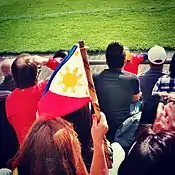
Some fans have organized themselves to support the national team, one of them is the Ultras Filipinas, which formed in 2011.[50][51] The Kaholeros started out as a gathering of friends using Twitter calling for fans to watch games of the AFC Challenge Cup at the National Sports Grill in Greenbelt. The Ultras Filipinas was established when fans of Philippine Air Force F.C. and Ultras Kayas decided to form a support group for the national teams of the Philippines not necessarily just for the football team. The first outing of Ultras Filipinas was not for the national football team but for the national rugby union team. The two fan groups take alternative turns in cheering and chanting for the national team during games.[51]
Colors
| Kit Suppliers of the Philippine national team | |||
|---|---|---|---|
| Outfitter | Usage | ||
| From | Until | ||
| Puma | 1996 | ||
| Adidas | 1996 | ||
| Mizuno | 2008 | 2012 | |
| LGR | 2012 | ||
| Puma | 2012 | 2015 | |
| LGR | 2015 | present | |
The traditional home kit is similar to the France national team; blue jersey, white shorts, and red socks.[52] However, in recent times, the home and away kit has either been all-blue, all-red or all-white, currently is the all-white as home jerseys.[53] The current kit supplier of the national team is local firm, LGR Sportswear. German companies Adidas and Puma, as well as Japanese company Mizuno, has provided kits for the team in the past
Puma was the official outfitter of the national team during the 1996 AFC Asian Cup qualification.[54] Later that year, Adidas assumed that role and outfitted the team that participated at the 1996 Tiger Cup.[55]
For three years from March 2008, Mizuno served as the official outfitter and equipment supplier of the team. It also helped the national federation in its grassroots development program.[56][57] On 4 June 2012, Puma supplanted Mizuno's role with the national team.[58]
Local firm LGR Sportswear became the official kit provider of the national team in 2015 and a new set of kits made by LGR were unveiled to the public in on 5 June which was later used by the team at the 2018 FIFA World Cup qualifiers. The home and away kits were white and blue respectively. Filipino weave design and the three stars and the sun are present at the back of the home and away kits. The goalkeeper's kit is black and has a yellow trim on the chest area and a weave pattern with the three stars and the sun and azkals logo incorporated in the design, in front around the shoulder area. Adidas was also announced as the footwear sponsor of the team for the qualifiers[59] The current kits of the national team were introduced in latter part of 2016. The home kit is white, the away kit is red while a third kit which is blue was also used.[60]
Home
|
2010–11
|
2011
|
2012
|
2012–13
|
2013
|
2013–2015
|
2015–2016
|
2016–2017
|
2018
|
2019–present
|
Away
|
2010–11
|
2011
|
2012–13
|
2013
|
2013–2015
|
2015–2016
|
2016–2017
|
2018
|
2019–present
|
Names
Under the official FIFA Trigramme the team's name is abbreviated as PHI; this acronym is used by FIFA, the AFC and the AFF to identify the team in official competitions.[61] The team is also identified under the International Organization for Standardization (ISO) country code for the Philippines as PHL.[62] However the team was more commonly known as the RP, the acronym for the country's official name, Republika ng Pilipinas,[61] which the local press used when they referred to the team as the "RP Booters"[63] or the "RP XI".[64] This was until late October 2010 when the Department of Foreign Affairs decided to change the official abbreviation of the country from "RP" to "PH" or "PHL", to be in line with ISO standards.[65] The local press have since referred to the team as either "PH/PHL Booters"[66][67] or "PH/PHL XI".[68][69]
The national team is referred to as the "Azkals".[70] The name was coined when an online Philippine football community proposed the nickname Calle Azul (Spanish for Streets of Blue, referring to the color of their kit) which was modified to Azul Calle, shortened to AzCal, and finally became Azkal – a word that is similar to Filipino term Askal meaning street dog.[71] "Azkals" became a trending topic on Twitter during the semifinals of the 2010 AFF Suzuki Cup.[72]
They are also known as the "Tri–Stars" which is derived from the three stars on the Philippine flag, although this nickname is not frequently used.[73]
Home stadium
During the early years of the Philippine national team, they played their home matches at the Manila Carnival Grounds. By 1934 it became the site of the Rizal Memorial Sports Complex.[74] One of the facilities within the complex is the 12,000 capacity national stadium, known as the Rizal Memorial Track and Football Stadium or simply the Rizal Memorial Stadium. Since its opening, it has been the home venue of the Philippine national team until May 2015 where they declared the 25,000 seater and Philippine Sports Stadium in Bocaue, Bulacan as their new home. However, due to disappointing attendance numbers in PSS and RMS and an impressive crowd for Ceres–Negros F.C.'s run to the 2017 AFC Cup, the Philippine Football Federation decided to make Panaad Stadium as the national team's home again for the 2019 AFC Asian Cup qualifiers.[75]
The RMS has also become a hub for track and field. The continued use for athletics along with poor maintenance has deteriorated the stadium and the 1991 Southeast Asian Games was the last time it was used for international football matches. In early 2009, the Philippine Sports Commission planned to transform it to a modern football stadium which would make it usable by the national team for international matches.[76]
The national team also held official international matches at the Cebu City Sports Complex in Cebu City,[77] and at the Barotac Nuevo Plaza Field in Barotac Nuevo, Iloilo.[78]
| Philippines national football team home stadiums | ||||
|---|---|---|---|---|
| Image | Stadium | Capacity | Location | Last match |
 |
Philippine Sports Stadium | 20,000 | Santa Maria, Bulacan | v (25 November 2016; 2016 AFF Championship) |
 |
Rizal Memorial Stadium | 12,873 | Manila | v (27 March 2018; AFC Asian Cup 2019 qualification) |
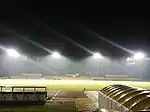 |
Panaad Stadium | 9,825 | Bacolod | v (15 October 2019; FIFA World Cup qualification) |
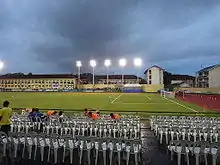 |
Cebu City Sports Complex | Cebu City | v (27 April 2014; Friendly) | |
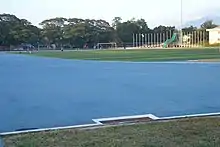 |
Quirino Stadium | 5,000 | Bantay, Ilocos Sur | v (26 June 2016; Friendly) |
Competitive records
Players
Current squad
The following 23 players were called up for the 2022 FIFA World Cup qualification match against Maldives and Syria in November 2019.[79]
Caps and goals updated as of 19 November 2019, after the match against Syria.
Recent call-ups
The following players have been called up for the Philippines within the past 12 months.[80]
| Pos. | Player | Date of birth (age) | Caps | Goals | Club | Latest call-up |
|---|---|---|---|---|---|---|
- Notes
INJ Withdrew from the squad due to an injury
RET Retired from the national team
SUS Omitted from the squad due to suspension
PRE Included in the preliminary squad
Fixtures and results
The following is a list of match results in the last 12 months, as well as any future matches that have been scheduled.
Head coaches
.jpg.webp)
One of the earlier head coaches of the national team was Dionisio Calvo. Foreign coaches of American, Argentinean, English, German, Scottish, Spanish, and Swedish nationality have managed the national team. Juan Cutillas has managed the team in at least four non-consecutive tenures (1969–1978, 1981–1984, 1996–2000 and 2008–09).
Thomas Dooley led the national team to its best finish in a tournament sanctioned by the Asian Football Confederation and FIFA by leading the team to second place at the 2014 AFC Challenge Cup. The past three coaches, Simon McMenemy, Michael Weiß and Thomas Dooley, also made some strides at the regional level leading the team to the semifinals at the AFF Suzuki Cup (2010, 2012 and 2014 editions respectively), the top football tournament in Southeast Asia. Eckhard Krautzun also led the national team to the semifinals, its best finish at the 1991 Southeast Asian Games, before football became an under-23 tournament at said multi-sporting event.
| List of head coaches of the Philippines | |||
|---|---|---|---|
| Nationality | Name | Period | References/Notes |
| Dionisio Calvo | (1930, 1934, 1954) | ||
| Luis Javellana | (1956) | ||
| Ramon Echevarria Sr. | (1958) | [81] | |
| Fernando Giménez Álvarez | (1962) | ||
| Alan Rogers | (1962–63) | ||
| Danny McLennan | (1963) | ||
| Emilio Pacheco | (1967) | ||
| Juan Cutillas | (1967–72) | ||
| Florentino Broce | (1973–74) | [16] | |
| Juan Cutillas | (1975–78) | ||
| Bernhard Zgoll | (1980) | ||
| Juan Cutillas | (1981–84) | ||
| Alberto Honasan | (1987) | [82] | |
| Carlos Cavagnaro | (1989) | ||
| Eckhard Krautzun | (1991–92) | ||
| Mariano Araneta | (1993) | [83] | |
| Rodolfo Alicante | (1993) | ||
| Noel Casilao | (1993–96) | ||
| Juan Cutillas | (1996–2000) | ||
| Rodolfo Alicante | (2000) | ||
| Masataka Imai | (2001) | ||
| Sugao Kambe | (2002–03) | ||
| Aris Caslib | (2004–07) | [84] | |
| Norman Fegidero | (2008) | ||
| Juan Cutillas | (2008–09) | ||
| Aris Caslib | (2009) | ||
| Des Bulpin | (2009–10) | [85] | |
| Simon McMenemy | (2010) | [86] | |
| Michael Weiß | (2011–14) | [87] | |
| Thomas Dooley | (2014–18) | [88] | |
| Marlon Maro | (2017) | [note 1] | |
| Terry Butcher | (2018) | [91] | |
| Scott Cooper | (2018, interim) | [92][93] | |
| Anto Gonzales | (2018) | [note 2] | |
| Sven-Göran Eriksson | (2018–19) | [95] | |
| Scott Cooper | (2019, interim) | [96] | |
| Goran Milojević | (2019) | [97] | |
| Scott Cooper | (2019–20) | [98][99] | |
See also
- Philippines women's national football team
- Philippines national under-23 football team
- Philippines national under-21 football team
- Philippines national under-19 football team
- Philippines national under-17 football team
- Football in the Philippines
- Ultras Filipinas
Notes
- Head coach on a temporary basis. Maro only coached the team that took part at the 2017 CTFA International Tournament in Taiwan which was held in December 2017. Dooley remained the head coach.[89] Maro was supposed to lead a U22 side, but the matches of the CTFA International Tournament were recognized as Tier 1 "A" international matches hence the Philippine Football Federation sent a senior side with Maro as its coach in lieu of Thomas Dooley.[90]
- Head coach on a temporary basis. Gonzales only coached the team that took part at the 2018 Bangabandhu Cup in Bangladesh which was held in October 2018. Cooper remained the head coach.[94]
References
- John Duerden (5 October 2015). "'We could be the second Argentina': Tom Dooley on coaching the Philippines | Football". The Guardian. Retrieved 7 October 2015.
- "The FIFA/Coca-Cola World Ranking". FIFA. 10 December 2020. Retrieved 10 December 2020.
- Motoaki Inukai 「日本代表公式記録集2008」 Japan Football Association p.206
- Stokkermans, Karel. "Far Eastern Games". Rec.Sport.Soccer Statistics Foundation. Retrieved 24 March 2015.
- "Azkals forced to settle for second place at 2014 AFC Challenge Cup". GMA News Online. Retrieved 8 October 2015.
- https://sports.inquirer.net/30585/yearender-football-scales-new-heights-with-philippine-azkals
- https://multisport.ph/2018/03/why-the-azkals-asian-cup-qualification-matters-to-every-filipino/
- Thompson, Trevor (21 February 2014). "HISTORY : EUROPE'S FIRST STAR WITH ASIAN ROOTS". AFC Asian Cup 2015. Archived from the original on 25 December 2014. Retrieved 17 July 2014.
- "Tight race for medal glory between RP, Thailand". Philippine Daily Inquirer. 25 November 2005. Retrieved 29 March 2015.
- Collins, Sandra (2014). 1940 TOKYO GAMES – COLLINS: Japan, the Asian Olympics and the Olympic Movement. Routledge. pp. 179–180. ISBN 978-1317999669.
- Veroeveren, Piet. "2600th Anniversary of the Japanese Empire 1940 (Tokyo)". Rec.Sport.Soccer Statistics Foundation. Retrieved 25 December 2014.
- Ochoa, Francis; Duran, Janardan (25 January 2011). "PH football renaissance feeding off Azkals' rise". Philippine Daily Inquirer. Retrieved 26 March 2015.
- Philippine Football: Its Past, Its Future. University of Asia and the Pacific. 2016. pp. 49–50. ISBN 978-621-8002-29-6.
- "Philippine Football Federation". Philippine Olympic Committee. Philippine Olympic Committee. Archived from the original on 16 February 2015. Retrieved 30 March 2015.
- Romualdez, Johnny (17 January 2003). "13–1 football lose: Can it happen again?". Manila Standard Today. Retrieved 29 March 2015.
- "History of Football in the Philippines". philfootball.info. Philippine Football Federation. Archived from the original on 4 February 2006. Retrieved 19 June 2015.
- Maximus, Lucius (15 April 2014). "6: 1994 World Cup". HOW MALAYSIA NEVER REACHED THE WORLD CUP: Harimau Malaya's 40-Year Chronicle of Failure. Fixi Mono. ISBN 9789670374857. Retrieved 30 March 2015.
- "Miracles Malaysia can do without". New Straits Times. 29 November 1991. Retrieved 30 March 2015.
- "FIFA – Philippines: World Ranking". FIFA.com. Fédération Internationale de Football Association. Retrieved 25 August 2010.
- "Philippines on the up". AseanFootball.org. ASEAN Football Federation. 9 January 2007. Retrieved 25 August 2010.
- "RP booters write one for books" (reprint). Manila Bulletin. Find Articles. 21 November 2006. Retrieved 25 August 2010.
- "Preview: Malaysia v Philippines – Philippines confident despite striker shortage". ESPNsoccernet. ESPN Inc. 11 January 2007. Retrieved 25 August 2010.
- "RP XI downs East Timor in Tiger Cup" (Reprint). Manila Bulletin. Find Articles. 14 December 2004. Retrieved 25 August 2010.
- "Soccer-Philippines coach to quit national team, coach youngsters". Reuters. 22 February 2007. Retrieved 25 August 2010.
- "RP to skip football World Cup qualifiers". Philippine Daily Inquirer. 2 April 2007. Archived from the original on 14 December 2010. Retrieved 25 August 2010.
- "Record entries for SA World Cup". BBC Sport. British Broadcasting Corporation. 30 March 2007. Retrieved 30 March 2007.
- "Philippines making Asian Waves". FIFA.com. Fédération Internationale de Football Association. 26 June 2008. Retrieved 25 August 2010.
- "Philippines fail to qualify for AFC Challenge Cup". AseanFootball.org. ASEAN Football Federation. 18 May 2008. Retrieved 25 August 2010.
- Nathanielsz, Ronnie (26 October 2008). "Philippines edged out of Suzuki Cup". Inside Sports. Retrieved 25 August 2010.
- Sauras, Joaquin; Lill, Felix (3 March 2014). "The Street Dogs of Manila". The Blizzard – the Football Quarterly. Blizzard Media Ltd (12).
- "Philippines stun defending champions". FIFA.com. Fédération Internationale de Football Association. 5 December 2010. Retrieved 9 February 2011.
- Tupas, Cedelf (27 November 2012). "PH eleven remembers the miracle of Hanoi". Philippine Daily Inquirer. Retrieved 31 March 2015.
- Gutierrez, Paul (3 December 2014). "'AZKALS' seek morale support". Journal Online. Archived from the original on 2 April 2015. Retrieved 31 March 2015.
- "FIFA.com – 2014 FIFA World Cup Brazil". FIFA.com. Fédération Internationale de Football Association. Retrieved 3 July 2011.
- "Turkmenistan 2–1 Philippines". The-AFC.com. Asian Football Confederation. 16 March 2012. Retrieved 16 March 2012.
- "Philippines 4–3 Palestine". The-AFC.com. Asian Football Confederation. 19 March 2012. Archived from the original on 23 July 2012. Retrieved 22 March 2012.
- "Historic win Azkals crush Indonesia". Yahoo! Philippines Sports. Archived from the original on 29 November 2014. Retrieved 26 November 2014.
- "Azkals yield 3–1 result to Vietnam, enter Suzuki Cup semis as 2nd seed". GMA News. 28 November 2014. Retrieved 12 December 2014.
- "Azkals fall to superior Thailand, 3-nil, to bow out of Suzuki Cup semis". GMA News. 10 December 2014. Retrieved 12 December 2014.
- "PHL Azkals stun Yemen with two goals in World Cup Qualifiers in Doha". GMA News Online. Retrieved 7 October 2015.
- "Philippines create history". Asian Football Confederation. 27 March 2018. Retrieved 29 March 2018.
- Agcaolli, Lance (28 March 2018). "Azkals make history". BusinessMirror. Retrieved 28 March 2018.
- "Channel News Asia". Archived from the original on 3 February 2019. Retrieved 4 February 2019.
- #AsianCup2019 Philippines 0-3 China PR Philippine Football Federation, 12 January 2019
- Asian Cup 2019. Kyrgyzstan 3 - Philippines 1 KABAR, 16 January 2019
- https://rappler.com/sports/football/fifa-world-cup-qualifier-game-results-philippines-syria-september-5-2019
- http://pff.org.ph/2019/09/10/guam-1-4-philippines/
- http://pff.org.ph/2019/11/15/maldives-1-2-philippines/
- https://www.fifa.com/worldcup/news/syria-edge-closer-as-central-asian-duo-move-top
- Sacamos, Karlo (4 December 2014). "Kaholeros' dogged determination: Azkals' travelling fans make presence felt in enemy territory". Sports Interactive Network Philippines. Retrieved 27 March 2015.
- Smit, Hans and Jamlang, Jing (Hosts); Villaflor, Ysabel and Daniel, Xerxes (Guests) (24 September 2015). Kaholeros and Ultras Filipinas (Podcast). Hans-On. Philippines: NMF Sports.
- Geraldes, Pablo Aro. "National Teams – Team Colors". RSSSF. Retrieved 20 October 2010.
- Guerrero, Bob (8 October 2013). "New Azkals shirt unveiled, plus other Football notes". The Passionate Fan. Yahoo! Philippines. Archived from the original on 2 April 2015. Retrieved 27 March 2015.
- "Puma continues support for football". Manila Standard Today. 27 January 1996. Retrieved 31 March 2015.
- Amigo, Ismael (7 September 1996). "Filipinos face Singaporeans Today". Manila Standard Today. Retrieved 26 March 2015.
- "Philippines FA sign with Mizuno". AseanFootball.org. ASEAN Football Federation. 16 March 2008. Retrieved 6 May 2010.
- "PFF, Mizuno sign P9-M contract". Mizuno.ph. Mizuno Corporation Philippines. 3 April 2008. Archived from the original on 31 January 2009. Retrieved 6 May 2010.
- "New Philippines Away Kit 2012-2013- Azkals Puma Jersey 12–13". Football Kit News. 4 June 2012. Retrieved 5 June 2012.
- Leongson, Randolph (4 June 2015). "Azkals unveil locally-made kit for World Cup qualifiers". Philippine Daily Inquirer. Retrieved 4 June 2015.
- "Philippines 2016/17 LGR Home, Away and Third Kits". Football Fashion.org. 23 November 2016. Retrieved 6 December 2016.
- "Country info – Philippines". FIFA.com. Fédération Internationale de Football Association. Retrieved 20 October 2010.
- "ISO 3166 Country Codes". Ciolek.com. ISO 3166 Maintenance Agency. Retrieved 20 October 2010.
- "RP booters – Google News Archive Search". Retrieved 20 October 2010.
- "RP XI – Google News Archive Search". Retrieved 20 October 2010.
- Lee-Brago, Pia (29 October 2010). "DFA junks 'RP' for 'PH' or 'PHL'". The Philippine Star. Retrieved 1 November 2013.
- Terrado, Jonas (6 December 2010). "PH booters make history". Manila Bulletin. Retrieved 9 February 2011.
- Perez, Jon (2 December 2010). "PHL booters force fancied Singapore to 1–1 draw". GMAnews.tv. Retrieved 9 February 2011.
- Tupas, Cedelf P. (8 December 2010). "PH XI shocks defending champ Vietnam, 2–0". Philippine Daily Inquirer. Archived from the original on 9 December 2010. Retrieved 9 February 2011.
- "Phl XI plays Myanmar to scoreless draw". The Philippine Star. 9 December 2010. Retrieved 9 February 2011.
- Lao, Edward (28 January 2000). "Philippine United: First Pinoy football team in UK". ABS-CBNNews.com. Retrieved 3 December 2010.
- Limpag, Mike (3 April 2011). "Limpag: I started a joke..." Sun Star. Cebu. Archived from the original on 6 April 2011. Retrieved 15 October 2011.
- Dimacali, TJ (17 December 2010). "Azkals beat Timnas Indonesia – on Twitter". GMANews.tv. Retrieved 21 December 2010.
- "Football Team Nicknames". Top End Sports. Retrieved 8 January 2011.
- "Leisure – Trivia". Abante (in Filipino). Manila. 27 May 2007. Archived from the original on 15 July 2007. Retrieved 25 August 2010.
- Tupas, Cedelf (8 March 2017). "Impressed by turnout, PFF sends Azkals back to Panaad". Philippine Daily Inquirer.
- Navarro, June (29 March 2009). "PSC plans to restore RMSC football field". Philippine Daily Inquirer. Archived from the original on 31 March 2009. Retrieved 13 May 2010.
- Alison, Mars (18 November 2012). "Historic Azkals-Lions friendly introduces sons of Cebu to local football fans". Philippine Daily Inquirer. Cebu Daily News. Retrieved 26 March 2015.
- "Philippines Fail to Qualify for AFC Challenge Cup". lloilo City: ASEAN Football Federation. 18 May 2008. Retrieved 26 March 2015.
- "Philippines MNT Lineup For Maldives And Syria Matches On 14 And 19 November 2019". Philippine Football Federation. 9 October 2019. Retrieved 11 November 2019.
- "Azkals' build-up for Suzuki Cup continues in Bangladesh". ABS-CBN News. 1 October 2018. Retrieved 13 November 2018.
- "DLSAA Sports Hall of Fame Awardees".
During the Third Asian Games in Tokyo in 1958, he coached the Philippine National Football Team defeating Japan before 60,000 spectators at the National Stadium, and placing 6th among 14 participating Asian nations.
- Japa, Raffy (26 March 1987). "Elizalde to the rescue". Manila Standard. p. 8. Retrieved 29 April 2015.
Alberto Honasan has been designate coach of the team
- "Fegidero uses old magic on Malaysia". Manila Standard Today. Bacolod. 13 May 1993. Retrieved 26 March 2015.
"We lack serious games which can only be attained in overseas tournament", said head coach Mariano Araneta
- Saaid, Hamdan (19 July 2007). "ASEAN Football Federation Championship - Details". RSSSF.
- "Brit takes Philippines role". skysports.com. 12 November 2009.
- "Simon McMenemy is the new PHL national team head coach". Filipino Football. 28 August 2010. Retrieved 8 December 2010.
- Tupas, Jeffrey M. (9 January 2011). "PFF approves hiring of German coach for Azkals". Inquirer.net. Philippine Daily Inquirer Inc. Archived from the original on 12 January 2011. Retrieved 11 January 2011.
- Teng Kiat (7 February 2014). "Philippines appoint Dooley as new coach". Goal.com. Retrieved 7 February 2014.
- "Philippines National Team In CTFA International Tournament". Philippines Football Federation. 28 November 2017. Retrieved 28 November 2017.
- Guerrero, Bob (28 November 2017). "Azkals to join pocket tournament in Taiwan". Rappler. Retrieved 28 November 2017.
- Christian Jacinto (14 June 2018). "New Philippine coach Terry Butcher says he wants Azkals to win 'with finesse and skill'". Sports Interactive Network Philippines. Retrieved 14 June 2018.
- "Irish coach joins Azkals coaching staff as senior football adviser". Rappler. 14 June 2018. Retrieved 15 June 2018.
- "Scott Cooper takes role as Azkals senior adviser, set to work hand in hand with Butcher". Spin PH. 14 June 2018. Retrieved 15 June 2018.
- Averilla, Earl (5 October 2018). "Azkals march into semis with clean slate in Bangabandhu Cup". Fox Sports. Retrieved 6 October 2018.
- "Sven-Goran Eriksson: Ex-England manager named Philippines boss". BBC Sport. 27 October 2018. Archived from the original on 28 October 2018. Retrieved 27 October 2018.
- "Football: Stephan Schröck, Daisuke Sato lead Azkals in PH-China friendly". 5 June 2019. Retrieved 5 June 2018.
- https://www.dugout.ph/vets-youngster-to-flag-azkals
- Averilla, Earl. "A significant step: Sven-Goran Eriksson's appointment as new Azkals head coach". Fox Sports Asia. Retrieved 28 October 2018.
- http://theazkals.com/technical-staff/ |Azkals Technical Staff
External links
- Philippine Football Federation
- Philippines at FIFA.com
- Philippines – World football elo ratings at ELOratings.net (Includes past fixtures & results)
 Media related to Philippines national football team at Wikimedia Commons
Media related to Philippines national football team at Wikimedia Commons Media related to Matches of the Philippines national football team at Wikimedia Commons
Media related to Matches of the Philippines national football team at Wikimedia Commons Quotations related to Philippines men's national football team at Wikiquote
Quotations related to Philippines men's national football team at Wikiquote
